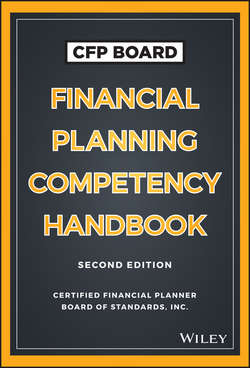Читать книгу CFP Board Financial Planning Competency Handbook - Board CFP - Страница 13
На сайте Литреса книга снята с продажи.
PART One
Introduction
CHAPTER 1
Theory and Practice
STUDENT-CENTERED LEARNING OBJECTIVES BASED ON CFP BOARD PRINCIPAL TOPICS
ОглавлениеThe notion behind the development of student-centered learning objectives is certainly not new to higher education, but it is part of a significant shift in the development of learning experiences across all disciplines. The shift is from an input-oriented curricular design to a student-centered outcomes approach where theoretical content, learning experiences, and assessment are based on predetermined student achievement benchmarks. As Toohey suggests:
A teaching strategy is.. a plan for someone else’s learning, and it encompasses the presentations which the teacher might make, the exercises and activities designed for students, materials which will be supplied or suggested for students to work with, and ways in which evidence of their growing understanding and capacity will be collected. 15
The purpose of student-centered learning objectives is to develop concrete benchmarks for students relative to content. These objectives, developed by academics and practitioners from across the profession and validated by a separate group of faculty and professional peers, can assist with not only determining what a student should be able to do relative to content, but also how to assess whether the student has acquired the necessary skills under the correct context.
Each of the chapters in Part One of this book contains a section devoted to student-centered learning objectives. These objectives are designed to outline what the student should be able to do relative to the particular chapter topic. Practitioners are encouraged to examine each of these outcomes to determine their own effectiveness relative to the topic area. Whether working in the field of personal financial planning or a related discipline, practitioners can benefit from a better understanding of their own effectiveness relative to these important concepts in personal financial planning. It may be that if the practitioner self-identifies areas of specific weakness in these objectives, he or she may decide to enroll in a continuing education program that can assist in improving efficacy relative to this topic.
Students enrolled in personal financial planner preparation programs are encouraged to examine these learning objectives not only to determine their own levels of preparation for entering the field of personal financial planning, but also to better understand the requirements associated with their particular programs of study. Although each program is different, the topics contained in this book have been determined by faculty and practitioners to be integral to personal financial planning.
Faculty teaching in personal financial planning courses or related fields of study are encouraged to explore these objectives to determine appropriate program and course outcomes, learning experiences, theoretical content, and assessment measures. Some faculty teaching in related fields may have students enrolled in their courses who aspire to become personal financial planners. Although some faculty may not be personal financial planners themselves, their content is critical to preparing future practitioners and thus necessary in the program of study. Faculty in these related disciplines are encouraged to examine these outcomes to learn how their content directly relates to personal financial planning and perhaps explore ways of making their course work more directly applicable to financial planning if at all possible.
Higher education in many countries is evolving toward a more student-centered approach to instruction, meaning that it is no longer the objective of a unit, course, or program of study to merely cover a list of topics relative to a specific discipline. Rather, the success of instruction is dependent upon whether students are able to achieve at a predetermined benchmark relative to a unit, course, or program of study.
Assessment has become a driving factor in higher education reform around the world. Institutions, and therefore faculty, are asked to document student achievement relative to concepts and subject matter. The development, identification, and utilization of these objectives provide a template for faculty when developing student assessment tools. These objectives can assist not only in determining student achievement and placement, but also in assessing instructional effectiveness at the unit and program levels.
15
Susan Toohey, Designing Courses for Higher Education (Buckingham, UK: Society for Research into Higher Education and Open University Press, 1999).
